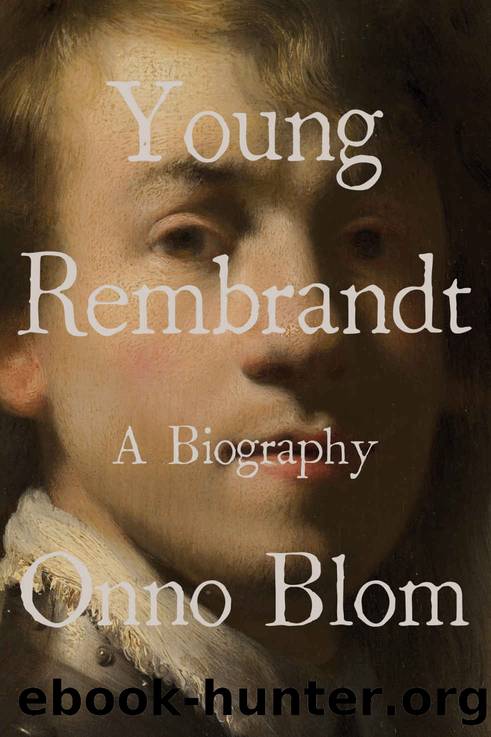Young Rembrandt: A Biography by Onno Blom

Author:Onno Blom [Blom, Onno]
Language: eng
Format: azw3
Publisher: W. W. Norton & Company
Published: 2020-09-07T16:00:00+00:00
The Slaughtered Ox, 1655.
There was a constant toing-and-froing in that section of the narrow street, especially with maidservants and other women who were off to the tripe hall or Penshal to purchase bacon, blood pudding, sausage or tripe. There were two entrances to the Penshal market: one on Breestraat, the other on Langebrug, diagonally opposite the Van Swanenburg residence. The latter was called the âSheep Gateâ: its stone arch, dating from 1607, displays an image of a ram holding Leidenâs coat of arms.
The Penshal was not an actual hall but a small square with covered colonnades on either side. It had once hosted a haberdashery market, but now it was the place where offal such as liver, kidneys, brains and lungs were arrayed on stone tables beneath the arcades, carved and sold. There were only two approved sites for the sale of meat in Leiden. Beef was sold at the meat market in the town hall, while pork and offal were traded in the Penshal. This facilitated good hygienic practices and produced clarity for those charged with levying excise duties.
While the meat trade at the town hall was conducted by men, it was women who sold low-quality offal at the Penshal. These market womenâthe âbacon or tripe wivesââmainly catered for the poorer sections of the local community. Rembrandt would have seen slaughtered cows dangling in the indoor meat market in a splayed posture resembling the upside-down crucifixion of the Apostle Peter, the carcass sliced open. Did he shudder at the sight? In 1655, he depicted the cruel beauty of a crucified ox, in an image that would in later centuries serve as a source of inspiration to Chaim Soutine and Francis Bacon.
We do not know why Rembrandtâs parents chose to apprentice him to Jacob van Swanenburg. One might have thought Joris van Schooten, Leidenâs most highly esteemed and experienced master painter at the time, would have been a more obvious choice. Simon van Leeuwen wrote in his brief history of Leiden (Korte besgryving van het Lugdunum Batavorum nu Leyden, 1672) that Van Schooten was in fact Rembrandtâs first teacher, but there is no corroborating evidence for this.
Father and mother Van Rijn moved in the same non-dogmatic circles as the Van Swanenburg family, whose influence was sharply curtailed after the 1618 purge of the local executive. Even so, Rembrandtâs parents would have hoped that a scion of that family might be able to introduce their son into the world of city magistrates, patrons and art collectors. Perhaps the story of Jacobâs long sojourn in Italy also had a certain appeal. He was the only painter in Leiden who boasted foreign experience of this kind.
Art historians have endlessly insisted that Jacob van Swanenburg did not exert a shred of influence on his brilliant pupil. But are they right? According to Orlers, who himself owned a âmagical pieceâ by Master Jacob, Rembrandt developed his skills so rapidly with Van Swanenburg âthat art lovers were quite amazed, and that it was abundantly plain that he would mature with the passage of time into an outstanding Painterâ.
Download
This site does not store any files on its server. We only index and link to content provided by other sites. Please contact the content providers to delete copyright contents if any and email us, we'll remove relevant links or contents immediately.
Papillon by Henry Charrière(796)
Watercolor With Me in the Forest by Dana Fox(589)
The Story of the Scrolls by The Story of the Scrolls; the M(556)
This Is Modern Art by Kevin Coval(459)
A Theory of Narrative Drawing by Simon Grennan(455)
Frida Kahlo by Frida Kahlo & Hayden Herrera(445)
Boris Johnson by Tom Bower(442)
Banksy by Will Ellsworth-Jones(435)
AP Art History by John B. Nici(429)
Van Gogh by Gregory White Smith(425)
The Art and Science of Drawing by Brent Eviston(423)
Draw More Furries by Jared Hodges(422)
Glittering Images: A Journey Through Art From Egypt to Star Wars by Camille Paglia(418)
Scenes From a Revolution by Mark Harris(413)
War Paint by Woodhead Lindy(413)
100 Greatest Country Artists by Hal Leonard Corp(391)
Ecstasy by Eisner.;(386)
Young Rembrandt: A Biography by Onno Blom(373)
Theater by Rene Girard(355)
